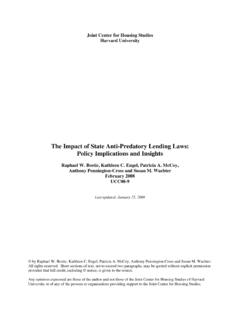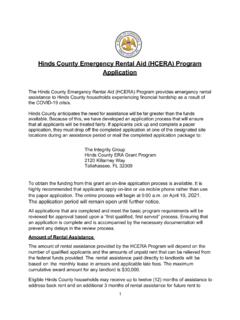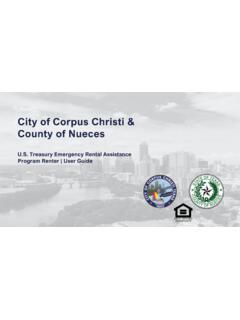Transcription of America's Rental Housing 2022 - jchs.harvard.edu
1 A M ER I CA'S R EN TAL HOUS I N G 202 2. Joint Center for Housing Studies of Harvard University JOINT CENTER FOR Housing STUDIES OF HARVARD UNIVERSITY. HARVARD GRADUATE SCHOOL OF DESIGN. HARVARD KENNEDY SCHOOL. CONT ENTS. 1. Executive Summary 1. 2. Renter Households 9. 3. Rental Housing Stock 16. 4. Rental Markets 23. 5. Rental Affordability 30. 6. Rental Housing Challenges 37. Interactive Data & Resources: Principal funding for this report was provided by Wells Fargo. 2022 by the President and Fellows of Harvard College. The opinions expressed in America's Rental Housing 2022 do not necessarily represent the views of Harvard University, the Policy Advisory Board of the Joint Center for Housing Studies, or Wells Fargo. 1 | EXECUTIVE SUMMARY. Rental Housing demand came roaring back in the second year of the pandemic, reducing vacancy rates and driving up rents. Some of this rebound reflects the lack of inventory in the for-sale market, which has kept many higher-income renters from buying homes.
2 At the same time, lower-income households that took the brunt of job losses during the lockdown still struggle to cover their rents. While unprecedented levels of federal assistance helped keep evictions down, the need for a permanent, fully funded Housing safety net is more urgent than ever. A key element of that support must be to protect the existing stock against the threats from climate change. REBOUND IN Rental MARKETS. After a cooldown early in the pandemic, Rental Housing markets heated up again in 2021. The Housing Vacancy Survey put the number of renter households at million in the third quarter of the year, an increase of about 870,000 households from the first quarter of 2020. With this resurgence in demand, the overall Rental vacancy rate dropped to just percent its lowest reading since the mid-1980s. In the professionally managed apartment market, the number of renter households shot up by a record percent in the third quarter of 2021 from a year earlier.
3 Conditions in the higher-quality segment tightened the most, with vacancy rates falling percentage points from the last quarter of 2020, to percent. Vacancy rates also declined by more than a percentage point year over year in both the moderate- and lower-quality segments, to the percent range. As a result, ask- ing rents for all professionally managed apartments spiked in the third quarter, led by a percent jump for units in higher-quality buildings (Figure 1). Strong Rental demand has kept the prices of apartment properties on the rise. Indeed, price appreciation was 21. Joint Center for Housing Studies of Harvard University 1. at a record high of percent in October 2021, push- indicates growing investor interest in single-family ing capitalization rates down to just percent in the Rental properties. third quarter. Despite soaring prices, favorable interest rates and ready access to capital helped to lift Rental property acquisitions from early-pandemic lows.
4 COVID'S LINGERING FINANCIAL IMPACTS. Indeed, multifamily mortgage originations surged in While most tenants managed to keep up to date on rent the third quarter, increasing by a record 105 percent. throughout the pandemic, some 15 percent of renter households were in arrears in the third quarter of 2021. The ownership of Rental properties continues to At the same time, nearly a quarter of renter households shift from individuals to business entities. According reported that they had lost employment income in the to the latest Rental Housing Finance Survey, the previous four weeks. share of Rental properties owned by non-individual investors rose 8 percentage points from 2001 to 2018, Lower-income renters were especially hard hit by income to 26 percent. This trend may well have continued losses and likely to fall behind on rent. Fully 23 percent through the third quarter of 2021, when investor of households with incomes below $25,000, along with purchases of homes many of which are ultimate- 15 percent of those with incomes between $25,000 and ly converted to rentals hit their highest level in $50,000, were behind on their payments in the third two decades.
5 Fully 74 percent of those purchases quarter of 2021. By comparison, just 5 percent of house- were single-family homes, a record-high share that holds making more than $75,000 owed back rent. 2020 2021. Mar May Jul Sept Nov Jan Mar May Jul Sept . Apr Jun Aug Oct Dec Feb Apr Jun Aug Oct Eviction CARES Act CDC Orders Moratoriums emergency Consolidated Appropriations Act ($25 billion). Rental assistance American Rescue Plan Act ($ billion). Stimulus Up to $1,200 $600. Checks $1,400. Expanded $600 per Week $300 per Week Unemployment 2 America's Rental Housing 2022. Disproportionately large shares of Black and Hispanic issued economic impact payments, providing much- renter households have also had difficulty keeping needed cash directly to households. Student loan defer- up with their Housing payments. Nearly a quarter of rals, monthly child tax credit payments, and increased Black renters were behind on rent in the third quarter, Supplemen-tal Nutrition assistance Program (SNAP).
6 As well as 19 percent of Hispanic renters. The share of benefits also helped renter households weather the Asian renter households in arrears was slightly lower massive job layoffs. at 18 percent, while the share of white renter house- holds was half that, at 9 percent. This disparity reflects But even with these income supports, millions of rent- long-term discrimination in labor markets that has ers were unable to pay for their Housing . Two subse- consigned many households of color to low-wage jobs quent bills passed in late 2020 and early 2021 provided in the service industry the sector that suffered the emergency Rental assistance (ERA) to help households most drastic job cuts over the past two years. pay back-rent and cover their current Housing and util- ity bills, ensuring their Housing security while also stabi- The pandemic's financial impacts may extend well lizing property owners' incomes.
7 Beyond missed rent payments. A recent Joint Center for Housing Studies analysis found that more than two- However, getting these funds into the hands of eligible thirds of renters that had lost employment income had renters posed significant challenges for state and local used multiple resources to cover their living expenses, governments, many of which had to create assistance including drawing down savings, increasing their cred- programs from scratch. In addition, the initial require- it card debt, and borrowing from friends and family. ments for documenting hardship and income losses Many also spent their economic impact payments and were burdensome to renters, and many households increased unemployment insurance benefits on rent were either unaware of the assistance available or and other basic needs. Even households that ultimate- unsure of their eligibility. As a result, just 1 percent ly fell behind on rent reported that they had borrowed of funds from the first ERA allocation were spent in from friends and family, potentially widening the pan- the first three months of the program.
8 By the end of demic's spillover effects not only to landlords but also October 2021, however, the share of ERA1 funds dis- to the broader community. bursed was up to 49 percent, with support reaching just over million households. EFFORTS TO STABILIZE RENTERS All of these measures have provided a backstop for Keeping renters in their homes has been a priority since many renter households that could well have lost their early in the pandemic. The CARES Act moratorium on Housing . Indeed, the Eviction Lab reports that eviction evictions, targeted to renters living in properties with filings declined sharply at the beginning of the pandem- federally backed mortgages, was put in place in March ic and remained 40 percent below historical averages in 2020 (Figure 2). After that moratorium expired in July, November 2021. While filings rose after the second CDC. the Centers for Disease Control and Prevention (CDC) moratorium ended, the increase through the fall was issued back-to-back holds on evictions in September smaller than expected.
9 This suggests that some combi- 2020 and August 2021. The first CDC order extended nation of emergency Rental assistance , income supports, to renters that met certain income requirements and and landlord flexibility has forestalled evictions. attested to hardship, while the second was restricted to areas with high COVID transmission but still covered about 90 percent of renters. ONGOING AFFORDABILITY CHALLENGES. Despite a strong economy, the share of renter house- At the same time, the federal government quickly holds with cost burdens fell only marginally in the years expanded unemployment insurance benefits and leading up to the pandemic. In 2019, some 46 percent of 21. Joint Center for Housing Studies of Harvard University 3. renters were at least moderately cost burdened (spend- Indeed, the cost-burdened share of renters earning ing more than 30 percent of income for rent and utili- under $30,000 has consistently held above 75 percent ties), including 24 percent with severe burdens (spend- since 2001 (Figure 3).)
10 Half of these lower-income renters ing more than half of income for Housing ). Although with cost burdens are households with older adults or down from the peak of 51 percent in 2011, the overall with children. share of cost-burdened renters was still nearly 6 per- centage points higher in 2019 than in 2001. Dedicating a large share of income to rent and utilities leaves little left for other necessities, including food The number of cost-burdened renter households also and healthcare. In 2019, the median renter household remained elevated in 2019, at million an increase had $2,400 each month to cover expenses other than of 38 percent from 2001. Still, there were 883,000 fewer Housing . But cost-burdened households with incomes households with cost burdens in 2019 than at the below $30,000 had just $360 to spend each month, an peak in 2014. All of this recent improvement reflects amount that would not cover basic needs in even the a decline in the number of cost-burdened households most affordable areas of the country.















